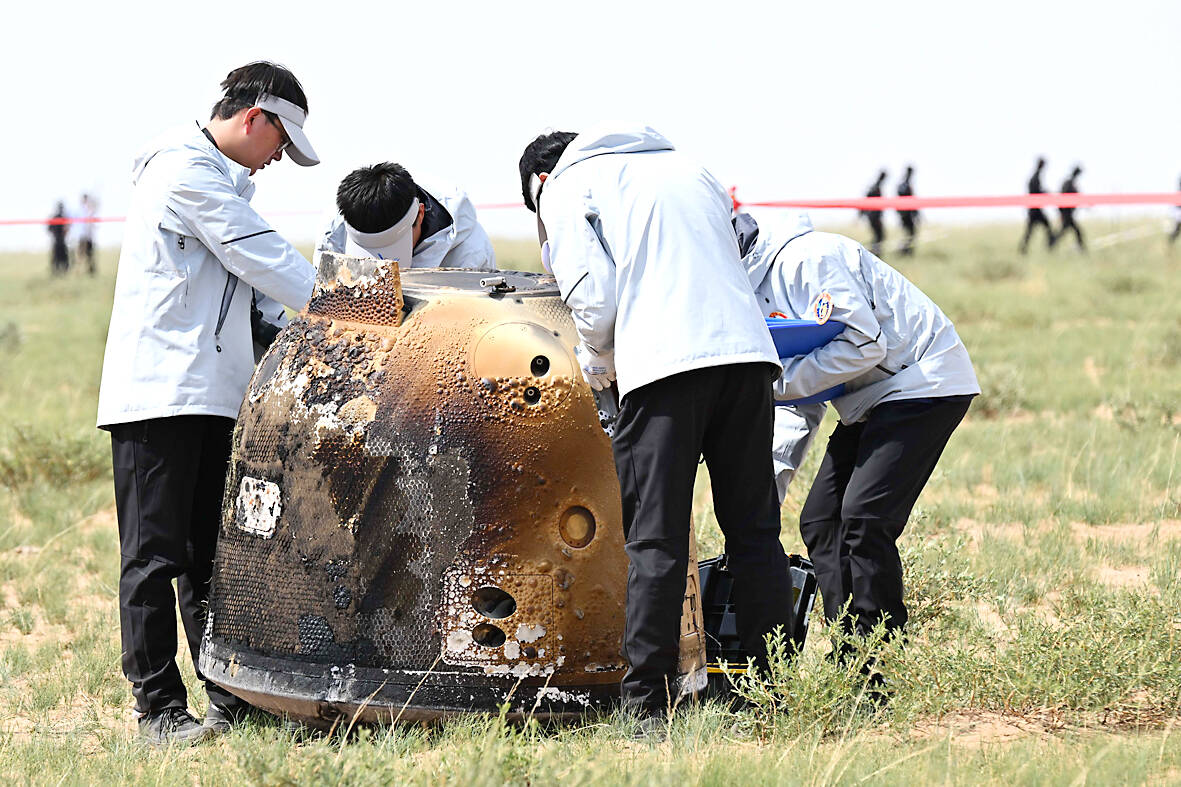A historic lunar mission has demonstrated China’s growing scientific prowess, but the feat has set off a torrent of misinformation targeting the US that researchers say reflects their bitter competition in space.
China is celebrating the return of the Chang’e 6 probe to Earth on Tuesday bearing rock-and-soil samples from the little-known far side of the Moon, following a 53-day mission that reignited old conspiracy theories about NASA’s Apollo Moon landings.
AFP’s fact-checkers have debunked a litany of Chinese-language posts suggesting NASA’s historic mission in 1969 — that first landed humans on the Moon — was staged as well as posts misrepresenting decades-old photos from subsequent landings.

Photo: EPA-EFE
The falsehoods, researchers say, risk stoking anti-US perceptions in China amid already fraught relations between Washington and Beijing, as the superpowers engage in an intensifying space race.
“There is undeniably a great power rivalry in space between the US and China, and any kind of misinformation about the activities by either country is concerning,” said Saadia Pekkanen, from the University of Washington. “It is yet another way that the potential for space diplomacy can be negated in the geopolitical competition between the two countries.”
When China’s National Space Agency released a photo of a stone-made Chinese flag erected on the Moon’s far side by Chang’e-6 in early June, users on Twitter (X) compared it with an image of NASA astronaut Harrison Schmitt standing next to a US flag on the lunar surface in 1972.
Posting to tens of thousands of followers, they falsely suggested the Apollo 16 mission must have been staged because Schmitt’s cloth flag was pictured being “blown” by the wind — despite NASA’s explanation that it used a horizontal bar to hold it upright.
‘INSECURITY’
Posts comparing the images on China’s Weibo platform attracted a flood of comments, with one user with more than 13 million followers writing that the photos proved that “Americans did not land on the Moon.”
Other users shared a photo of the German band Rammstein dressed as astronauts with their helmets off, with one sarcastic caption on Weibo reading: “Now you believe that the US moon landing was real.”
Decades-old photos from NASA’s Apollo missions in the late 1960s and early 1970s have also been recycled by social media users claiming they were actually from China’s groundbreaking lunar mission.
Beijing has poured huge resources into its space program over the past decade in a bid to close the gap with the US and Russia.
China aims to send a crewed mission to the Moon by 2030 and plans to build a base on the lunar surface, while the US is also planning to put astronauts back on the Moon by 2026 with its Artemis 3 mission. It was not clear whether the misinformation was fueled by Chinese state-backed actors, but the rapid spread on tightly controlled social networks has raised questions about their possible support or involvement.
“Beijing sometimes lets anti-American sentiments and false information run rampant on the Chinese internet, to allow for an escape valve for domestic tensions, and to modulate Chinese citizens’ views,” Isaac Stone Fish, chief executive of China-focused data company Strategy Risks, told AFP.
“Allowing conspiracy theories on the US moon landing to fester may reflect insecurity on Beijing’s part on the space race between China and the United States.”
‘SPREAD A LIE’
Researchers say the misinformation campaign suggests a frequent tactic of recycling existing conspiracy theories to sow online distrust.
“There is large online community that is happy to talk about the moon landing conspiracy,” said Darren Linvill, from Clemson University. “If this audience can be harnessed to spread a lie that puts China in a more positive light, that is all the better for China.”
Chinese state media coverage strongly praising the Chang’e-6 probe’s success has simultaneously been critical of the US. Washington has warned that Beijing’s space program is being used to mask military objectives and an effort to establish dominance in space.
The nationalist Global Times newspaper reported that the Chang’e-6 mission demonstrated China’s “open and inclusive attitude toward international cooperation” in contrast to the US, which it said was “busy chanting the ‘China threat’ in a so-called space race.”
Against this backdrop, AFP debunked Chinese-language posts on Facebook, Weibo, TikTok and its Chinese sister app Douyin quoting the White House press secretary as saying that the US and China landed on “different moons” after being asked why the Chang’e-6 found “no traces” of NASA’s mission. The exchange was entirely fabricated.
“Chinese people can be justifiably proud of their lunar module’s historic trip to collect samples,” Stone Fish said.
“They don’t need to fall victim to the old conspiracy theory that the US has staged moon landings.”

The canonical shot of an East Asian city is a night skyline studded with towering apartment and office buildings, bright with neon and plastic signage, a landscape of energy and modernity. Another classic image is the same city seen from above, in which identical apartment towers march across the city, spilling out over nearby geography, like stylized soldiers colonizing new territory in a board game. Densely populated dynamic conurbations of money, technological innovation and convenience, it is hard to see the cities of East Asia as what they truly are: necropolises. Why is this? The East Asian development model, with

June 16 to June 22 The following flyer appeared on the streets of Hsinchu on June 12, 1895: “Taipei has already fallen to the Japanese barbarians, who have brought great misery to our land and people. We heard that the Japanese occupiers will tax our gardens, our houses, our bodies, and even our chickens, dogs, cows and pigs. They wear their hair wild, carve their teeth, tattoo their foreheads, wear strange clothes and speak a strange language. How can we be ruled by such people?” Posted by civilian militia leader Wu Tang-hsing (吳湯興), it was a call to arms to retake

This is a deeply unsettling period in Taiwan. Uncertainties are everywhere while everyone waits for a small army of other shoes to drop on nearly every front. During challenging times, interesting political changes can happen, yet all three major political parties are beset with scandals, strife and self-inflicted wounds. As the ruling party, the Democratic Progressive Party (DPP) is held accountable for not only the challenges to the party, but also the nation. Taiwan is geopolitically and economically under threat. Domestically, the administration is under siege by the opposition-controlled legislature and growing discontent with what opponents characterize as arrogant, autocratic

When Lisa, 20, laces into her ultra-high heels for her shift at a strip club in Ukraine’s Kharkiv, she knows that aside from dancing, she will have to comfort traumatized soldiers. Since Russia’s 2022 invasion, exhausted troops are the main clientele of the Flash Dancers club in the center of the northeastern city, just 20 kilometers from Russian forces. For some customers, it provides an “escape” from the war, said Valerya Zavatska — a 25-year-old law graduate who runs the club with her mother, an ex-dancer. But many are not there just for the show. They “want to talk about what hurts,” she